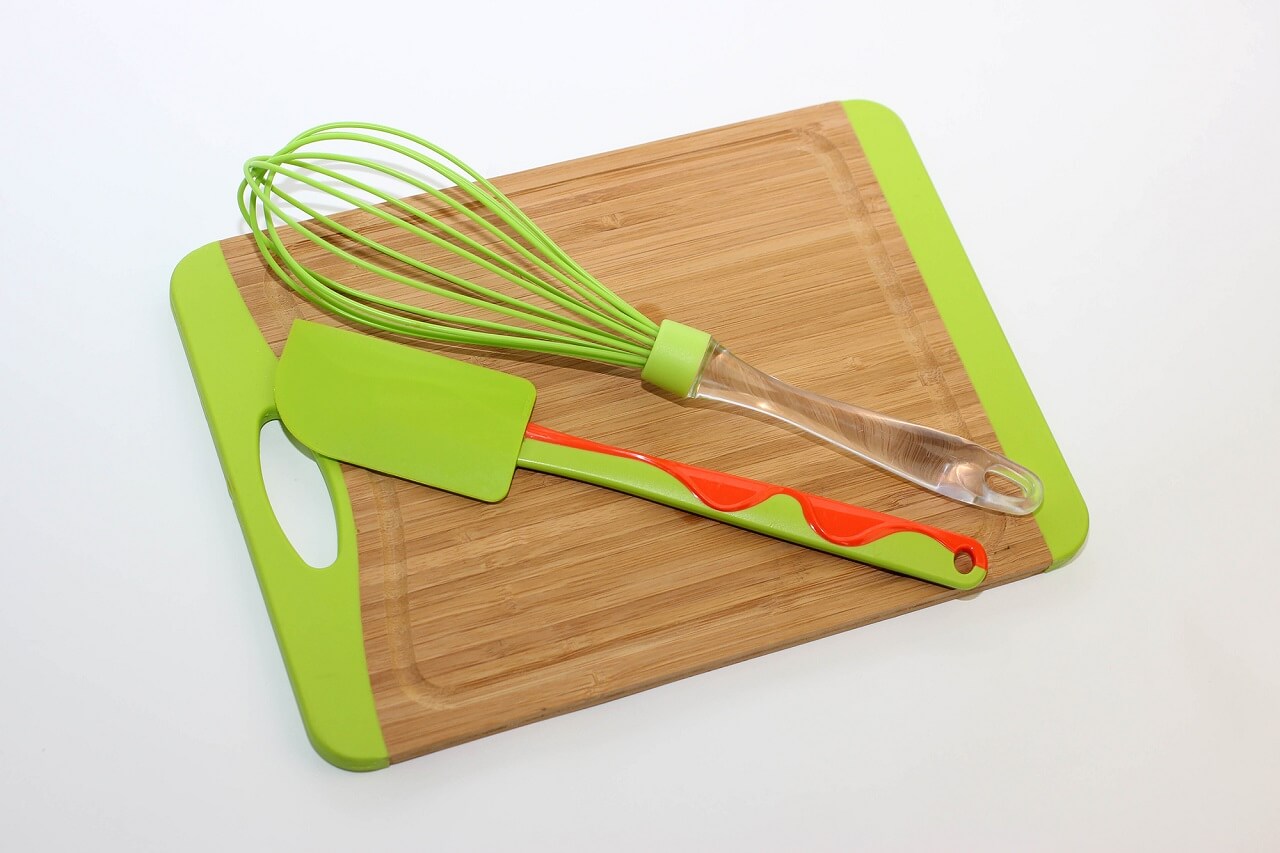If you’re bored of wooden spoons and want to get a bit more 21st century, you may be wondering “Can I use a silicone spatula for cooking?”
The answer is yes, of course you can. It’s actually a great way of stirring, scraping and mixing, and there are advantages to them over other utensils. Read on!
Can I Use A Silicone Spatula For Cooking?

The short answer to this is yes, yes you can! Food grade silicone has been specially designed to withstand the hot temperatures of cooking.
This type of utensil is long lasting, and is perfect for all the different types of cooking that goes on in your kitchen.
They are very easy to wash and to keep clean – you can wash them in the sink, and they will also survive the dishwasher.
Silicone is made from silicon, hydrogen, carbon and oxygen. These are all pretty natural ingredients, so you shouldn’t have to worry about cooking with silicone.
Another advantage to silicone cookware is that it is perfect for use with non-stick pans – no worries about removing that non-stick coating with these!
Obviously you shouldn’t leave them on the hob, or forget about them in the oven – but they will do a great job in the kitchen.
Some people recommend using silicone utensils only for colder foods, and sticking to metal or wood for really hot dishes.
However, you really don’t need to worry too much – these are perfect for use with all types of cooking, and can even be more convenient than other materials.
The FDA has approved food grade silicone for cooking, which means that it won’t release any harmful chemicals into your food.
Some people are suspicious of using anything but wood or metal to cook with – but this is the 21st century, so we might as well embrace new technology that makes our lives easier!
Will A Silicone Spatula Melt?
Your silicone spatula is designed to be used for cooking, and as such it is not likely to melt easily.
They are generally heat resistant to between 180 and 300 degrees, so you shouldn’t have a problem unless you accidentally blowtorch it!
The silicone spatula should also be able to keep its shape despite the high temperatures, and won’t get melted into a mess.
The only exception to this is the spatulas with plastic handles or which are hollow – these can be affected by high temperatures and may melt.
It is a strange feeling, to be cooking with something that we are expecting to melt into a pile of goo any second!
Remember that silicone is also used to make baking trays and muffin cases, so they are going to be fine in a standard kitchen.
As long as you don’t deliberately leave it on the gas hob overnight, your silicone spatula will be safe for cooking – and it won’t melt.
Here’s a little video explaining how and why your silicone spatula is made to be heat proof:
How Do I Know If My Silicone Spatula Is Heat Resistant?
Unlike plastic spatulas, silicone spatulas are designed not to melt or break if they are exposed to high temperatures.
You can test this, of course, by sticking your spatula in the oven and baking it, but this is not advised!
You can always look up your particular brand of spatula online to see what temperature it is rated to, but most are safe up to high temperatures.
Most spatulas, usefully, have a maximum recommended temperature stamped right on them, so you shouldn’t have to look too far to discover how hot it is allowed to get.
Different spatulas and different manufacturers can vary, so it’s always a good idea to check your individual spatula before you decide how hot it can get.
This article will tell you all about the pros and cons of silicone utensils.
Can I Use A Silicone Spatula In Boiling Water?
Thankfully, you don’t need to worry about accidentally melting your spatula – and ruining your food – if you stir something boiling with it.
You can happily use these utensils in boiling liquids, as they are safe for anything that is under 600 degrees Farenheit.
The other good news about this is that your silicone spatula will definitely be dishwasher safe – that’s one less thing to wash by hand!
It’s not advisable to stick your silicone spatula in a pan bubbling on the stove for hours, but you don’t have to worry about stirring something hot.
Which Is Better Silicone Or Rubber Spatula?
Both of these materials are great for using in your cooking – they are easy to use and easy to clean. But which is better?
Rubber spatulas are ideal for scraping out bowls and making sure that no food is wasted – but silicone ones are equally flexible and can do this as well.
A silicone spatula is heat resistant, meaning that it is very unlikely to melt even during your hottest cooking experiments, while rubber can melt.
Both of these spatulas are safe to put in the dishwasher – though if you are worried you can always wash them by hand.
A little note on rubber AND silicone – some of them have plastic handles. These can be affected by high temperatures, so keep safe with your cooking.
Silicone is approved as safe for cooking, and it will not release any harmful chemicals into your cooking – there is a little doubt around rubber, however.
Silicone is easy to use, affordable and completely safe – as well as convenient.
Silicone spatulas are a clear winner, for us anyway! Test out both and see which one works best for you.
Silicone, despite the fact that it looks like rubber and you’d be forgiven for thinking it’s going to melt, is actually a great material to use for cooking implements.
Once you have started using silicone in your cooking, chances are you will never look back!